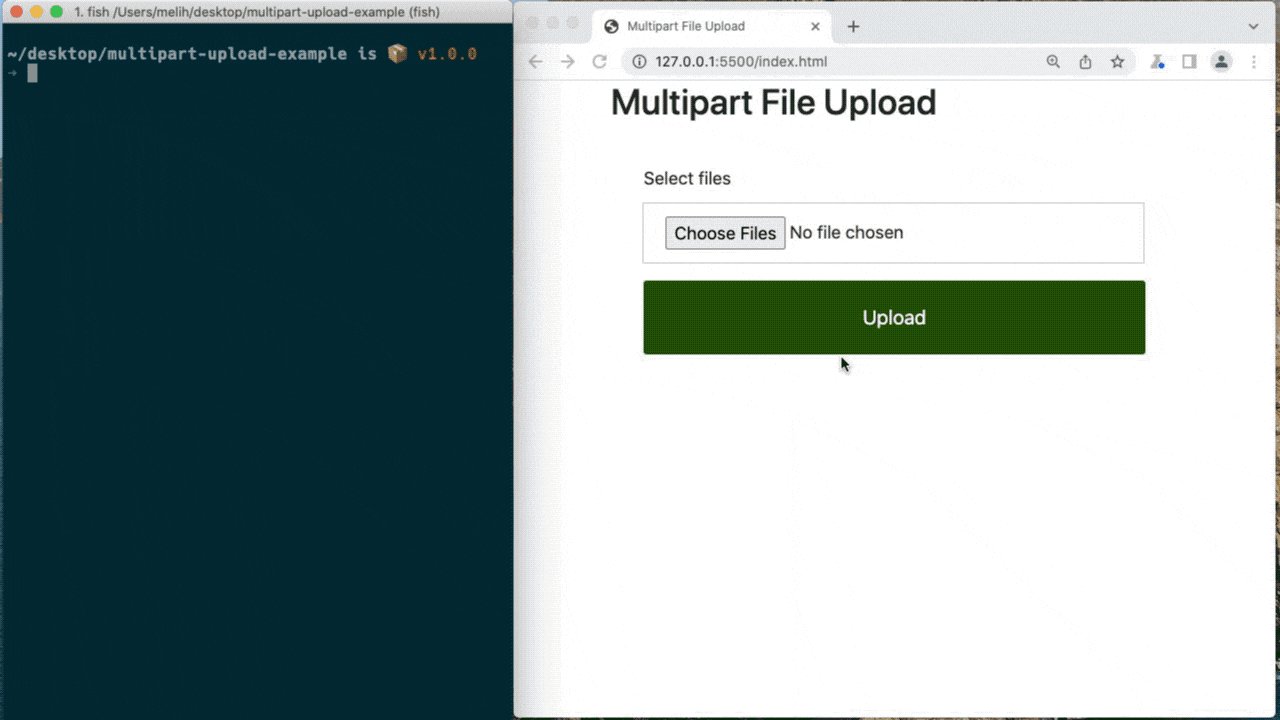In this guide, we will look at how we can upload a file from HTML form data to a server with the multipart-upload method. Multipart-Upload is commonly used method for sending files or data to a server.
What is Multipart Upload Request?
A multipart request is a HTTP request that HTTP clients construct to send files and data over to a HTTP Server. It is commonly used by browsers and HTTP clients to upload files to the server.
Example
We will take a file from the user with FormData and send it to the server. First, let's create our fields for the user to choose a file using HTML form.
<body>
<div class="container">
<h1>Multipart File Upload</h1>
<form id="form" enctype="multipart/form-data">
<div class="input-group">
<label for="files">Select files</label>
<input id="file" type="file" multiple />
</div>
<button class="submit-btn" type="submit">Upload</button>
</form>
</div>
<script src="index.js"></script>
</body>

Here we simply created an input and a button. With these HTML elements we have created, we can get the file chosen by the user.
Let's make a request with JavaScript and Fetch to send the selected files to the server.
const form = document.getElementById("form");
const inputFile = document.getElementById("file");
const formData = new FormData();
const handleSubmit = (event) => {
event.preventDefault();
for (const file of inputFile.files) {
formData.append("files", file);
}
fetch("http://localhost:8080/files", {
method: "post",
body: formData,
}).catch((error) => ("Something went wrong!", error));
};
form.addEventListener("submit", handleSubmit);
We added the file we received from the user with the input file to FormData. We then created a request to send this FormData object to the server.
Now, let's create a simple server using Express and Multer in order to see that the files we sent are received by the server successfully.
NOTE
Multer: JavaScript middleware for handling multipart/form-data , which is used for uploading files.
import express from "express";
import cors from "cors";
import multer from "multer";
const app = express();
//Cross-Origin Resource Sharing (CORS) is an HTTP-header based mechanism that allows a server to indicate any origins
app.use(cors());
const storage = multer.diskStorage({
destination: (req, file, cb) => {
cb(null, __dirname + "/uploads");
},
filename: (req, file, cb) => {
cb(null, file.originalname);
},
});
const Data = multer({ storage: storage });
app.post("/files", Data.any("files"), (req, res) => {
if (res.status(200)) {
console.log("Your file has been uploaded successfully.");
console.log(req.files);
res.json({ message: "Successfully uploaded files" });
res.end();
}
});
app.listen(8000, () => {
console.log("Server is running");
});
As you can see, we have created our multer structure and a simple server to run locally in order to manage and receive FormData.
The requests we created to send files by JavaScript will now be sent to our local server.

How to Multipart Upload with Refine?
The Multipart file upload process with Refine is very simple. How to use it is explained step by step in the guide and example.
Refer to the Refine Multipart Upload guide for more information. →
Example
npm create refine-app@latest -- --example upload-antd-multipart


